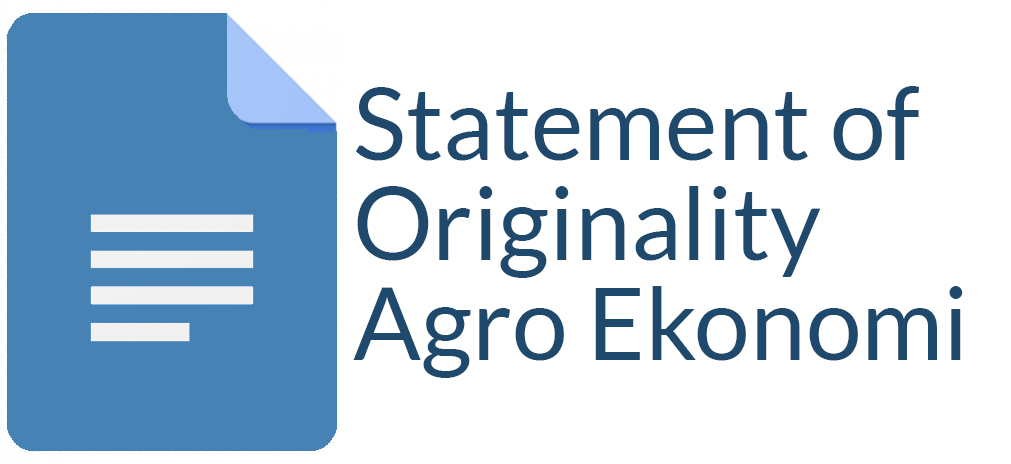Farmer’s Motivation Towards Agroforestry-Based Agriculture to Utilize Understorey-Cropping System in BKPH Purworejo KPH Kedu Selatan
Fitri Lusiana Kurniasari(1), Alia Bihrajihant Raya(2*), Roso Witjaksono(3)
(1) Study Program of Agricultural Extension and Communication, Department of Agricultural Socio-economics, Faculty of Agriculture, Universitas Gadjah Mada
(2) Study Program of Agricultural Extension and Communication, Department of Agricultural Socio-economics, Faculty of Agriculture, Universitas Gadjah Mada
(3) Study Program of Agricultural Extension and Communication, Department of Agricultural Socio-economics, Faculty of Agriculture, Universitas Gadjah Mada
(*) Corresponding Author
Abstract
Agroforestry is a land management technique to be used together with the society in the cultivation of forestry and agricultural commodities. The concept of agroforestry carried out in BKPH of Purworejo, KPH Kedu Selatan, both high economic agroforestry crops, such as rubber, coffee, cocoa, teak, mahogany, etc.; low economic agroforestry plants, such as dadap, lamtoro, kaliandra, etc.; and seasonal agroforestry plants, such as rice, corn, peanuts, and others. The land management is an important effort to improve the quality and quantity of agricultural production, which included in extensification efforts. This research aims to determine farmers' motivation in cultivating agroforestry-based agricultural commodities, to determine factors that influence motivation in cultivating agroforestry-based agricultural commodities, and to determine the effect of motivation in cultivating agroforestry-based agricultural commodities on utilizing the understorey-cropping system at BKPH Purworejo. The method used in this research was descriptive quantitative analysis method. While the data processing method used was the proportion test and regression test. The results of this research indicated that approximately less than or equal to 50% of farmers have the low motivation of farmers to cultivate agroforestry-based agricultural commodities. Factors that have a positive effect on the motivation in cultivating agroforestry-based agricultural commodities included the role of agriculture-forestry extension agents and access to the marketing of agroforestry products. While the factor that has a negative effect on the farmer’s motivation is the obligation of farmers to cooperate with Perhutani. The motivation of farmers in cultivating agroforestry-based agricultural commodities has a positive effect on utilizing the understorey-cropping system at BKPH Purworejo, KPH Kedu Selatan.
Keywords
Full Text:
PDFReferences
Aditya, L. 2017. Inovasi Lembaga Masyarakat Desa Hutan (LMDH) Wana Lestari dalam Pengelolaan Hutan Tanaman Nyamplung di Desa Patutrejo Kecamatan Grabag Kabupaten Purworejo (Translated title: Innovation of Wana Lestari Forest Village Community Institutions (LMDH) of in the Management of Nyamplung Plantation in Patutrejo Village, Grabag District, Purworejo Regency). Accessed on December 27, 2018. Available at file:///F:/jurnal/9203-20681-1-SM.pdf. Darwanto, D.H. 1999. Peranan irigasi pertanian dalam peningkatan produksi dan pendapatan petani (Translated title: The role of agricultural irrigation in increasing production and income of farmers). Jurnal Agro Ekonomi 6(1): 45-71. Dewati, R. dan L.R. Waluyati. 2018. Production risk of rice in Kebonsari Madiun regency. Jurnal Agro Ekonomi 28: 161-172. Oktalina, S.N., S.A. Awong, P. Suryanto, dan S. Hartono. 2015. Strategi petani hutan rakyat dan kontribusinya terhadap penghidupan di kabupaten Gunung Kidul (Translated title: The strategy of community forest farmers and their contribution to livelihood in Gunung Kidul district). Jurnal Kawistara 5(3): 298-309. Malian, A.H. 2017. Kebijakan perdagangan internasional komoditas pertanian Indonesia (Translated title: International trade policy of Indonesian agricultural commodities). Jurnal AKP 2(2): 135-156. Mustofa, M.S. 2011. Perilaku masyarakat desa hutan dalam memanfaatkan lahan di bawah tegakan (Translated title: The behavior of forest village people in utilizing land under forest stands). Jurnal Komunitas 3(1): 1-11. Saputri, R.D., S. Anantanyu, dan A. Wijianto. 2016. Peran penyuluh pertanian lapangan dengan tingkat perkembangan kelompok tani di kabupaten Sukoharjo (Translated title: The role of field agricultural extension with the level of development of farmer groups in Sukoharjo district). Jurnal Agrista 4(3): 341-352. Senoaji, G. 2012. Pengelolaan lahan dengan sistem agroforestry oleh masyarakat Baduy di Banten Selatan (Translated title: Land management with agroforestry systems by Baduy communities in South Banten). Jurnal Bumi Lestari 12(2), 283-293. Sriwidodo, U. dan A.B. Heryanto. 2010. Pengaruh kompetensi, motivasi, komunikasi dan kesejahteraan terhadap kinerja prgawai dinas pendidikan (Translated title: Effect of competence, motivation, communication and welfare on the performance of the education office employees). Jurnal Manajemen Sumberdaya Manusia 4(1): 47-57. Sumanto, S. E. 2009. Kebijakan pengembangan perhutanan sosial dalam perspektif resolusi konflik. (Translated title: Policy for developing social forestry in the perspective of conflict resolution) Jurnal Analisis Kebijakan Kehutanan 6(1): 13-25. Suprapto, E. 2010. Hutan Rakyat: Aspek Produksi, Ekologi, dan Kelembagaan. (Translated title: Community Forest: Production Aspects, Ecology, and Institutions). Accessed on December
Article Metrics
Refbacks
- There are currently no refbacks.
Copyright (c) 2018 Agro Ekonomi

This work is licensed under a Creative Commons Attribution-ShareAlike 4.0 International License.
View My Stats











